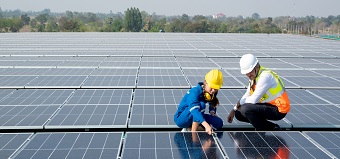What are the key workforce trends shaping the energy sector? Part 1
BLOG

WHAT ARE THE KEY WORKFORCE TRENDS SHAPING THE ENERGY SECTOR? PART 1

Our energy system is going through massive changes as the UK aims to achieve net zero by 2050. Similarly, the European Union has set a target to reduce greenhouse gas emissions by at least 55% by 2030, with renewable energy sources already accounting for 25% of the EU's energy mix in 2022. In the United States, the share of renewables in electricity generation is projected to reach nearly 50% by 2030.
A key part of making this transition a success is building a skilled workforce that can support these changes.
But as the industry changes, so too do hiring requirements. Due to new digital technologies, clean energy and changing regulations, many energy companies are struggling to fill growing talent gaps. To secure their current and future talent pipelines, organisations must understand these trends. Importantly, businesses must also start to factor these insights into hiring practices.
This is the first in a blog series on the future workforce of the energy sector. In this blog, we’ll see three key trends shaping the future of the energy sector. Then, in part two, we’ll offer actionable tips on how to address your energy sector talent gap.
How is the energy sector changing?
The world is moving away from traditional energy sources and towards a greener future. However, the energy industry — and the world as a whole — is currently in a state of transition between the two. Our reliance on natural gas and fossil fuels has not yet gone away. But the use of renewable energy is growing each year. Providers must serve both markets while meeting sustainability initiatives and incorporating new technologies.
As such, energy companies continue to hire for a wide range of energy technologies and roles. Among the many energy trends currently shaping the world, we see three key shifts. These primary trends are having the most impact on incoming talent. And without understanding these key trends, companies may find their talent supply chain lags behind the competition.
3 trends shaping the energy sector
1. Digitalisation
Digital technology is transforming how the energy industry operates. From improving home energy efficiency to the rise of automation in power generation, digital technologies are unavoidable. We’re currently witnessing how the integration of advanced digital tools could change our nation’s energy supply.
If implemented well, these technologies bring massive benefits. Internet of Things (IoT) devices help businesses to monitor their systems in real-time. These tools gather valuable data and optimise the way energy is produced and distributed. Other technologies also release staff from mundane tasks to concentrate on more pressing issues.
As in other industries, artificial intelligence (AI) and machine learning are proving valuable too. By using predictive analytics, companies can plan for power grid energy consumption and proactive maintenance. Combined, digitalisation will continue to help both suppliers and customers use energy more effectively. Including these skills in your hiring business model will mean you keep pace with future digitalisation.
2. The rise of renewable energy
As the energy sector moves towards greener sources, we’re seeing an increase in hiring for renewable energy skills. With this shift comes the need for a workforce capable of building, maintaining and improving these distributed energy resources.
While we still rely on traditional energy sources, we’re also seeing the green transition happen in real-time. In October 2024, we saw Britain’s last coal-fired power plant shut down. Elsewhere in Europe, Germany plans to phase out coal by 2038, with renewable energy sources already providing over 40% of its electricity. In the United States, renewable energy accounted for about 21% of electricity generation in 2022, with significant growth expected in the coming years.
Renewable energy sources are stepping up to meet any gaps in energy demand. Key future technologies like solar panels, wind turbines and battery storage systems are now contributing to our nation’s energy supply, with that number only set to grow.
However, creating this clean energy requires new skills, from design to installation and ongoing maintenance. This brings both hiring opportunities and challenges for all energy companies.
3. Energy transition policy
While energy production methods change, so too do policy, regulation and reporting requirements. Initiatives aimed at reducing carbon emissions and fighting climate change are forcing companies to rethink how they generate and use energy.
For example, the UK has set ambitious targets to increase its renewable energy capacity. These goals include significant expansions in offshore wind energy and solar power by 2030. Renewable energy projects like these come with increased reporting requirements around greenhouse gas emissions, ESG and other incentives.
And for energy companies, these policy changes are not just targets. We’re now seeing real-world demand for skills in areas like environmental compliance, sustainable energy planning and development. Future-thinking companies will need to build teams that can help them manage these technical and legal requirements. Energy jobs are changing to match long-term goals over short-term needs.
Managing the skills shortage for the energy industry
What conclusion can we draw from these trends? Primarily, that the energy sector faces a growing gap between the skills it needs and those available. With the push toward cleaner energy, many businesses are finding it challenging to recruit and train workers. Energy companies are seeking employees with the necessary expertise for the future of energy production.
Addressing this gap means rethinking talent development. Training programmes that upskill current employees will be essential. Similarly, there will be a change in initiatives that bring new workers into the sector. The end result will be building a talent pipeline that meets the needs of both the current and future energy industries.
In part two of this series, we’ll explore strategies you can use to bridge your energy sector skills gap.
